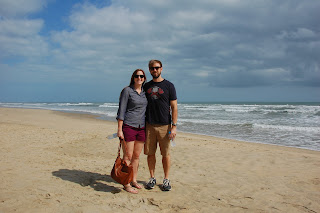After a chilly, but amazing time in Ha Long Bay we passed back through Hanoi before flying down to Central Vietnam to visit cities that reflect the imperial times of the country. We spent a few days between visiting Hue and Hoi An. Unfortunately, it was this part of the trip where the English ability of our tour guides decreased proportionally to our latitude. We saw a lot of great things, concentrated greatly to understand fun facts and historical stories about the places, and came away with some pseudo-knowledge about Vietnamese history. Amongst our pictures we'll share our Top Five Historical Facts about Vietnam...
1. When Vietnam split into two dynasties, the Trinh in the north and the Nguyen in the south, Hue served as the imperial city for the Nguyen from 1802 to 1945.
2. The Thien Mu Pagoda is now home to the car that the Buddhist monk Thich Quang Duc used during a demonstration in Saigon before setting himself on fire in protest to the Ngo Dinh Diem regime that persecuted Buddhists.
3. The French invaded Vietnam in the late 1800s, establishing Indochina in 1887 which included Vietnam, Laos, and Cambodia.
4. The kingdom of Champa, a Hindu and Buddhist kingdom, ruled Vietnam from the 7th century to 1832
5. Vietnam was split into two countries in 1954 with the Geneva Conference, following years of fighting between the Communist Party led by Ho Chi Minh (mainly in the North) and their opponents, comprised by nationalist Chinese, British and French. From 1954, Ho Chi Minh led North Vietnam from Hanoi and Ngo Dinh Diem led South Vietnam from Saigon.
So the historical facts are kind of random and don't necessarily go with all of the pictures, but hopefully that gives you a better idea of some of Vietnam's background. After our time in Hue/Hoi An, our adventure continued further south to Saigon (Ho Chi Minh City).
--Justin
1. When Vietnam split into two dynasties, the Trinh in the north and the Nguyen in the south, Hue served as the imperial city for the Nguyen from 1802 to 1945.
Hue's old imperial citadel
We took one of these dragon boats down the Perfume River to visit the Thien Mu Pagoda.
2. The Thien Mu Pagoda is now home to the car that the Buddhist monk Thich Quang Duc used during a demonstration in Saigon before setting himself on fire in protest to the Ngo Dinh Diem regime that persecuted Buddhists.
Here's the actual car used by Thich Quang Duc, with the famous photograph of his self-immolation on the wall.
The Thien Mu Pagoda is a place where under-privileged boys are sent by their parents to be educated.
The pagoda was situated on the Perfume River with beautiful views at the landscape around.
3. The French invaded Vietnam in the late 1800s, establishing Indochina in 1887 which included Vietnam, Laos, and Cambodia.
Tomb of emperor Minh Mang (1791-1841)
It was hard to believe that this tomb was less than 200 years old, since parts of it look like ancient ruins.
For comparison, we also visited emperor Khai Dinh's Tomb (1885-1925).
Khai Dinh wasn't too popular since he basically bankrupt the country building his tomb.
After Hue, we took a nice drive through the Hai Van Pass towards the city of Hoi An. We passed some picturesque rice fields along the way.
We were also able to take a break at this beach on the South China Sea.
Another point of interest was this set of battlements in the Hai Van Pass that was used during the Vietnam War.
4. The kingdom of Champa, a Hindu and Buddhist kingdom, ruled Vietnam from the 7th century to 1832
I'd never heard of the Cham people, but apparently a French archaeologist dug up a bunch of sites in the area between Hue and Hoi An and now there's a sizeable museum dedicated to sculptures by the Cham people. It does appear to be an interesting mix between Hindu and Buddhist inspired.
Before reaching Hoi An we visited some caves in the Marble Mountains, which had some stunning views.
5. Vietnam was split into two countries in 1954 with the Geneva Conference, following years of fighting between the Communist Party led by Ho Chi Minh (mainly in the North) and their opponents, comprised by nationalist Chinese, British and French. From 1954, Ho Chi Minh led North Vietnam from Hanoi and Ngo Dinh Diem led South Vietnam from Saigon.
It turns out that Hoi An has a nice beach, as well as a really neat central part for shopping and looking around. We were really disappointed to have our afternoon cut short here by arriving a couple of hours behind schedule.
View from our hotel over a waterway.
Since Marisa loves to cook we decided to join a Vietnamese cooking class while in Hoi An. We collectively made a beef salad (which I actually ate for a change), some fried spring rolls, and a fish wrapped in banana leaves. They also hooked us up with some bonus features, like a stuffed wanton that is locally famous. It wasn't as hands-on as it could've been, but we were happy to have something a little different.
The streets in Hoi An were loaded with all of these colorful lamps. Of course we had to bring some home.
So the historical facts are kind of random and don't necessarily go with all of the pictures, but hopefully that gives you a better idea of some of Vietnam's background. After our time in Hue/Hoi An, our adventure continued further south to Saigon (Ho Chi Minh City).
--Justin






























